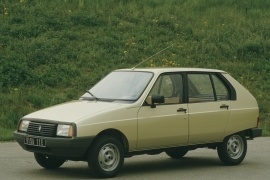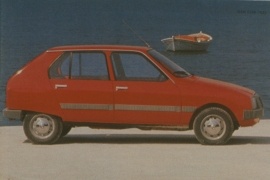CITROEN Visa Models/Series Timeline, Specifications & Photos
First production year: 1978
Engines: Gasoline, Diesel
Body style: Hatchback
At the beginning of the '80s, Citroen needed a car to compete in the European compact class.
In time, its dimensions downgraded the car into the small class. It did it with a Peugeot-based hatchback named Visa.
The Citroen Visa was created to replace the Ami, which was launched in 1961 and it was already old. Its design was not suitable anymore for a market that discovered the hatchback bodywork and its advantages, from the Renault 16. The first generation of the VW Golf appeared in the '70s.
The Visa was built on the same platform as the Peugeot 104. The wedged shape vehicle featured twin-round headlights and a grille with horizontal slats between them. An additional grille was incorporated under the bumper, to improve the cooling of the air-cooled engine.
The five-door bodywork offered enough room for five adult passengers and an average-sized trunk. As a strange feature, the hand-brake was for the front wheels and the spare-wheel was placed on top of the engine. Depending on the trim level, the Visa was offered with a stereo and a rear wiper.
Under the hood, the Visa was offered with a choice of gasoline or diesel engines. The former was offered with either a twin-cylinder or a flat-four, while for the latter only a 1.6-liter naturally aspirated diesel was available.
Citroen tried to develop a new vehicle to replace the aging 2CV, and the Visa seemed to be the perfect answer for that. In some way, it did, since it managed to sell in high numbers and in a few shapes.
By the late '70s, Citroen already knew that the hatchbacks were on the rise. Volkswagen already proved that with the boxy-looking Golf, and Honda also did well with the Civic. The French brand, on the other hand, relied on the Ami lineup to compete in the segment, and it was not doing it too well simply because that car had an unusual, rather ugly, design. And then, the Visa came.
Even though it sported a boxy design, the narrow front end, and the slightly curved body panels were a delight, at least compared to the Ami. Moreover, the carmaker ditched the oval-shaped headlights and replaced them with rectangular ones. Due to the fact that it featured air-cooled engines, it didn't need a large grille, so a smaller one was put in place. From the sides, the four-door version featured flush door handles. At the back, the raked-forward tailgate allowed for easy loading of luggage into the trunk.
The interior was cramped for the rear seats but very generous for the front passengers, thanks to the small engine placed in front of the gearbox. An unusual dashboard design led to a pair of side stacks next to the instrument cluster, one of them featuring the turn signal switches.
Under the hood, the carmaker placed a small range of flat engines, starting with a two-cylinders. As an option, the carmaker added a flat-four powerplant that provided an even better fuel efficiency than its smaller displacement engine.

